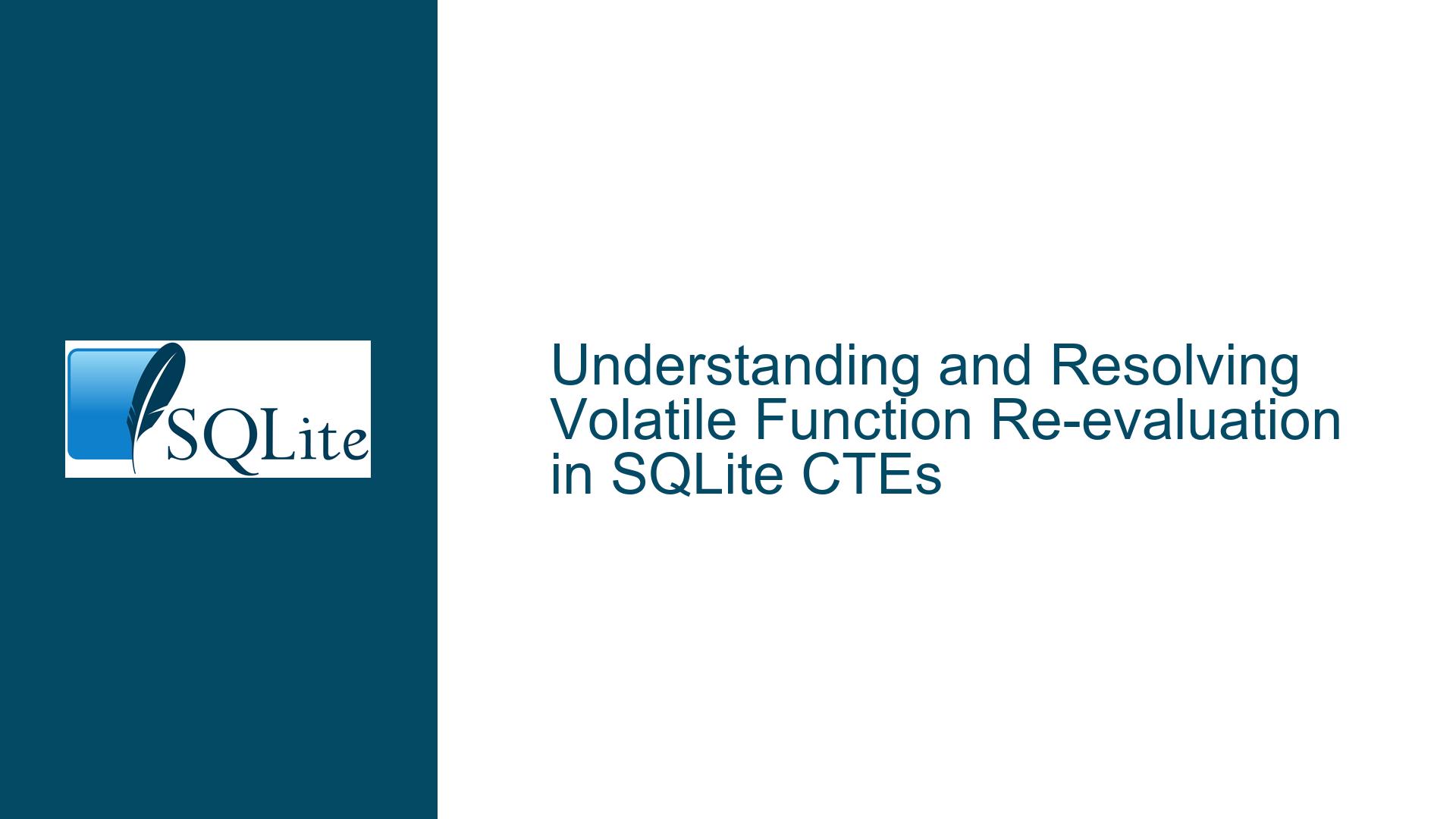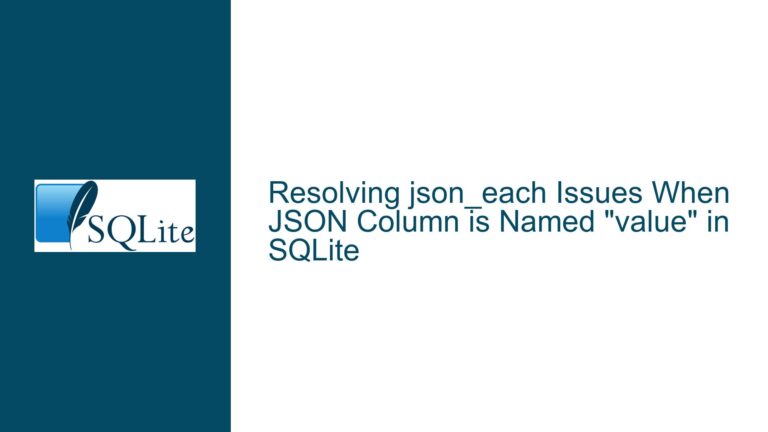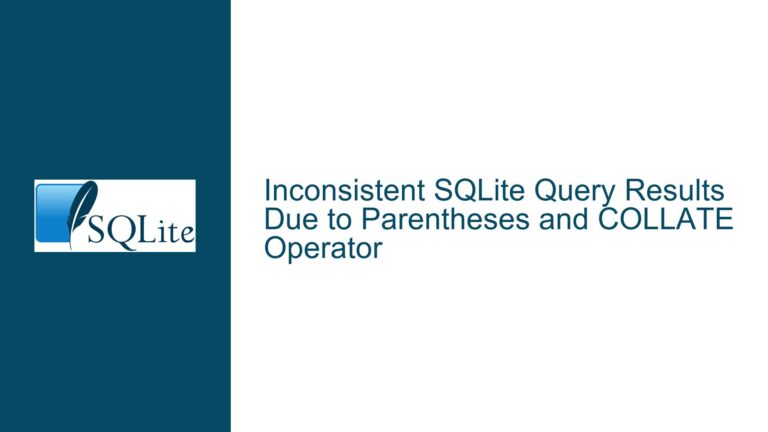and Resolving Volatile Function Re-evaluation in SQLite CTEs
Issue Overview: Volatile Functions in Common Table Expressions Yield Inconsistent Results Across Column References
The primary issue arises when using volatile functions, such as random(), within a Common Table Expression (CTE) in SQLite. When the CTE is referenced multiple times in the same row of an outer query, each reference may trigger a re-evaluation of the volatile function, leading to inconsistent values across columns. This behavior is observed when the CTE is not materialized (i.e., stored as a temporary result set). For example, in the query:
WITH rnds AS (SELECT random() & 255 AS rnd FROM (SELECT 1))
SELECT rnd, rnd, rnd FROM rnds;
The output might show three distinct values for rnd in a single row (e.g., 16 | 50 | 137). This occurs because the CTE is treated as a "co-routine" by the SQLite query optimizer, meaning it is re-evaluated for each reference to rnd. When the CTE is explicitly materialized using the MATERIALIZED keyword, the optimizer stores the result of the CTE in a temporary table, ensuring that all references to rnd return the same value. However, the MATERIALIZED and NOT MATERIALIZED clauses are only hints, and the optimizer may override them based on internal heuristics, leading to unpredictable results in edge cases.
The volatility of random() exacerbates this issue. Volatile functions return different values on each invocation, even if their inputs are identical. When the CTE is not materialized, every access to rnd triggers a new call to random() & 255, resulting in distinct values. This behavior contradicts the expectations of users who assume that a single row in the CTE would produce a single value for rnd across all references. The problem is particularly acute in scenarios where derived values (e.g., random IDs) must remain consistent within a row for subsequent operations like joins or data transformations.
Possible Causes: Query Optimizer Decisions, Volatile Functions, and CTE Materialization Hints
Volatile Function Behavior:
SQLite categorizes functions likerandom(),datetime('now'), andchanges()as volatile. These functions do not produce deterministic results and are re-evaluated every time they are referenced in a query. When a volatile function is embedded in a CTE, the optimizer may re-execute the function for each reference to the CTE column unless the CTE is materialized. This re-evaluation is not a bug but an inherent property of volatile functions in SQL.CTE Materialization Strategies:
SQLite employs two strategies for processing CTEs:- Co-routine Execution: The CTE is evaluated on-the-fly as a generator, interleaved with the outer query’s execution. This avoids materializing the entire result set upfront but risks re-evaluating volatile functions for each reference.
- Materialization: The CTE is fully evaluated and stored in a temporary table before the outer query runs. This ensures consistency across multiple references but incurs memory and performance overhead.
The optimizer chooses between these strategies based on factors like query complexity, CTE size, and presence of
MATERIALIZED/NOT MATERIALIZEDhints. However, these hints are not guarantees. For instance, even withMATERIALIZED, the optimizer may ignore the hint if it deems co-routine execution more efficient.Subquery Flattening and Optimization:
SQLite’s query optimizer often "flattens" subqueries and CTEs into the outer query to eliminate redundancy. While this improves performance, it can inadvertently merge the CTE’s logic into the outer query, causing volatile functions to be re-evaluated. The presence ofFROM (SELECT 1)in the original query introduces a synthetic subquery that may influence the optimizer’s decision to materialize the CTE or treat it as a co-routine.Ambiguity in CTE Hint Enforcement:
TheMATERIALIZEDandNOT MATERIALIZEDsyntax in SQLite serves as a hint rather than a directive. The optimizer retains final authority over materialization decisions. This ambiguity creates scenarios where the same query might produce different results across SQLite versions or under varying runtime conditions, undermining reproducibility.
Troubleshooting Steps, Solutions & Fixes: Ensuring Consistent Evaluation of Volatile Functions in CTEs
Step 1: Diagnose CTE Materialization Behavior
Begin by analyzing the query plan to determine whether the CTE is materialized. Use the EXPLAIN QUERY PLAN command:
EXPLAIN QUERY PLAN
WITH rnds AS (SELECT random() & 255 AS rnd FROM (SELECT 1))
SELECT rnd, rnd, rnd FROM rnds;
Look for keywords like MATERIALIZE or SCAN SUBQUERY in the output. A MATERIALIZE directive indicates the CTE is stored in a temporary table, while SCAN SUBQUERY or CO-ROUTINE suggests on-the-fly evaluation.
Step 2: Enforce CTE Materialization Explicitly
To ensure the CTE is materialized, use the MATERIALIZED keyword:
WITH rnds AS MATERIALIZED (SELECT random() & 255 AS rnd FROM (SELECT 1))
SELECT rnd, rnd, rnd FROM rnds;
While this is not a guarantee, it strongly encourages the optimizer to materialize the CTE. Verify the materialization by re-running EXPLAIN QUERY PLAN.
Step 3: Bypass CTEs with Subqueries
If the MATERIALIZED hint is unreliable, rewrite the query using a subquery in the FROM clause:
SELECT rnd, rnd, rnd FROM (
SELECT random() & 255 AS rnd FROM (SELECT 1)
);
This structure often forces materialization implicitly. Test the output for consistency across rnd references.
Step 4: Use Temporary Tables for Determinism
For critical workflows requiring absolute consistency, materialize the CTE into a temporary table manually:
CREATE TEMP TABLE temp_rnd AS
SELECT random() & 255 AS rnd FROM (SELECT 1);
SELECT rnd, rnd, rnd FROM temp_rnd;
DROP TABLE temp_rnd;
This approach guarantees a single evaluation of random() but introduces overhead from table creation and deletion.
Step 5: Leverage Scalar Subqueries
Compute the volatile value once in a scalar subquery and reference it repeatedly:
SELECT
(SELECT random() & 255 FROM (SELECT 1)) AS rnd1,
(SELECT rnd1) AS rnd2,
(SELECT rnd1) AS rnd3;
This ensures random() is called only once, but syntax variations may be necessary depending on SQLite version.
Step 6: Adjust Query Structure to Inhibit Flattening
Modify the CTE or subquery to include elements that discourage flattening, such as LIMIT or ORDER BY:
WITH rnds AS (
SELECT random() & 255 AS rnd FROM (SELECT 1) LIMIT 1
)
SELECT rnd, rnd, rnd FROM rnds;
The LIMIT 1 clause may prompt the optimizer to materialize the CTE to avoid redundant computations.
Step 7: Monitor SQLite Version-Specific Behavior
CTE materialization rules have evolved across SQLite versions. For example:
- Versions before 3.34.0 (2020-12-01) lack support for
MATERIALIZED/NOT MATERIALIZEDsyntax. - Version 3.35.0 (2021-03-12) improved CTE optimization heuristics.
Test queries under different SQLite versions and consult the SQLite changelog for relevant updates.
Step 8: Utilize Application-Layer Caching
If SQLite-level solutions are insufficient, compute the volatile value once in application code and inject it into the query:
# Python example
import sqlite3, random
rnd = random.randint(0, 255)
conn.execute("SELECT ?, ?, ?", (rnd, rnd, rnd))
This bypasses SQLite’s volatility mechanics entirely but couples the solution to the application layer.
Step 9: Advocate for Enhanced Materialization Controls
Engage with the SQLite community to propose stricter enforcement of MATERIALIZED hints or introduce new syntax (e.g., MATERIALIZED ENFORCED). Monitor SQLite mailing lists and forums for developments in CTE handling.
Step 10: Validate with Deterministic Function Proxies
Test queries using a user-defined deterministic function as a proxy for random() to isolate volatility-related issues:
-- Register a deterministic function in SQLite
sqlite3_create_function(db, "deterministic_random", 0, SQLITE_UTF8, NULL, &deterministic_random, NULL, NULL);
SELECT deterministic_random() & 255 AS rnd FROM (SELECT 1);
If the problem persists with deterministic functions, the issue likely stems from CTE materialization rather than volatility.
By systematically diagnosing materialization behavior, enforcing storage mechanisms, and adjusting query structure, users can mitigate inconsistent evaluations of volatile functions in CTEs. While SQLite’s optimizer introduces unpredictability, the solutions outlined above provide actionable pathways to achieve deterministic results where required.






